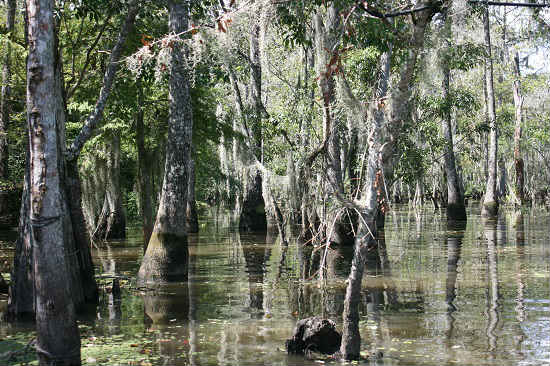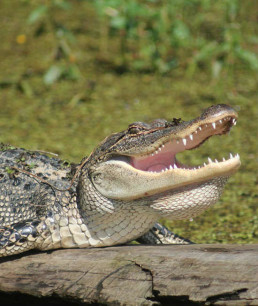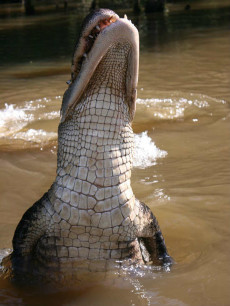

Crawfish pie, me oh my, Jambalaya….. gumbo, jazz and ……..the swamp?
Crowds serge down Bourbon Street in New Orleans around the clock, moving to the beat of live jazz and drawn to the smell of gumbo and jambalaya in one of the finest tourist towns in the nation. How many folks come to see the swamps and the critters that live within?
Sometimes people forget that this musical city that never sleeps is an island re-claimed from swampland and at any given point it is eight to ten feet below sea level protected from the gulf by its massive levies. That swampland is some of the most beautiful wilderness in all of the United States and home to a myriad of wildlife.
A half hours’ drive in almost any direction from down town will take you to a swamp tour where you can chose from a fast moving airboat that jets you along at high speed or a slow moving pontoon cruiser that will lazily thread its way under the massive Cypress trees hung thick with Spanish moss. It is a green, tranquil paradise teeming with wildlife, and there are so many fish that it is estimated that one quarter of all the seafood consumed within the United States comes from Louisiana. Crickets, cicadas, and bull frogs provide a constant harmonic serenade while flocks of massive blue herons and smaller white egrets fill the sky with color. Then there are the gators.

Alligators are an indigenous American amphibian reptile distinguishable from its larger African cousin the crocodile by their smaller size and teeth placement. Because of their physical similarity they share the same fierce reputation and that is unfounded.
I chose the swamp cruiser to visit these animals and no sooner had we left the dock than the hum of the engine drew them by the dozens. Within five minutes on the water we were surrounded by a dozen curious and hungry gators. The swamp boat captains are highly knowledgeable naturalists, most of who grew up in the local bayous and know every plant, tree, and critter, especially the gators. Thanks to my guide Captain Charlie, all previous stereotypes about alligators were quickly put to rest.
Unlike their cousins the crocodile, alligators only attack humans when threatened, and the people who share the swamp with them swim fearlessly alongside of them. While the gators massive jaws make it a formidable hunter, the muscles that open those jaws are so weak that the mere strength of a child is enough to hold them shut.
Captain Charlie would dangle hot dogs over the side of the boat and the alligators used their powerful tails to propel themselves straight up, almost completely out of the water, taking them like a dog jumping for a Frisbee. This allowed us to see their beautiful markings and colorful yellow underbellies. Charlie knew most of the gators and called them by name while regaling us with personal anecdotes about his life in the bayou.
It was a real surprise to find that after a few hot dogs the gators like their desert, so Charlie would toss marshmallows onto the water that were quickly gobbled up. It was not just the sweet flavor that they like, but gators normally only take food from the water’s surface and do not like anything that has sunk below, and marshmallows float. Seeing this fierce looking creature eating marshmallows put them into a whole new perspective.

Some may be surprised to learn that they sleep most of the time with their eyes and mouths open, usually while hauled out on the river bank or on an old log. Since a gator does not sweat, it passes off its body heat through an open mouth, much like a dog panting. They are as agile on land as in the water, and while they can easily outrun a man on foot, if they are startled they will head straight for the water rather than attack.
The people who make their full time home in the swamp always build on one side of a waterway while leaving the other bank undeveloped for their wildlife neighbors in a perfectly balanced symbiotic relationship.
This animal that is basically unchanged since prehistoric times is still hunted for food and can be found on most New Orleans menus, as well as for its hide that is used for everything from shoes to belts to ladies purses, however their numbers are so large that not only are they in no danger of becoming extinct, but there is an annual state sanctioned hunt just to keep the numbers under control. When the city of New Orleans was flooded during hurricane Katrina, gator hunters had to be brought into the city to clean them out of populated areas there were so many.
The good people of New Orleans have lived side by side with alligators and the beautiful swamps they inhabit for centuries, and this is one of the few places in the country where city folks can easily go out to see them personally.
For a special New Orleans treat, after you have had your crawfish pie and listened to some good jazz, head on out to the swamp to see the gators.
How to Get There:
Honey Island Swamp Tours is located at 41490 Crawford Landing Road, Slidell Louisiana. It is about a half hours drive from downtown New Orleans and northeast of mighty Lake Ponchartrain. They provide city pick up service for a slight fee.
Website: honeyislandswamp.com. Telephone, (985) 641- 1769
Tours last about two hours and all are guided and narrated by very knowledgeable boat captains. Young children are welcome.
Adult price is $25.00, Children under 12 are $12.00
There are usually two trips a day but call first for a reservation and to check on the weather.
- Life of a Champion: Exploring the Muhammad Ali Center in Louisville - April 19, 2024
- What It’s Like to Live as an Expat: Lake Chapala, Mexico - April 18, 2024
- Top 5 Spots for Stargazing in North Carolina - April 17, 2024
